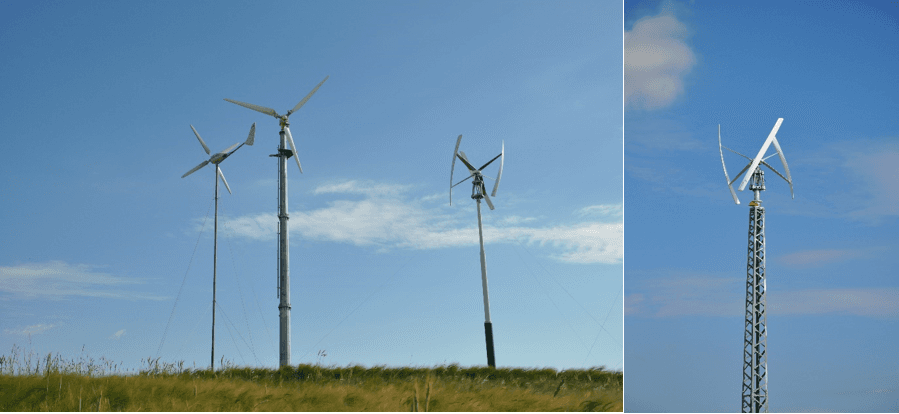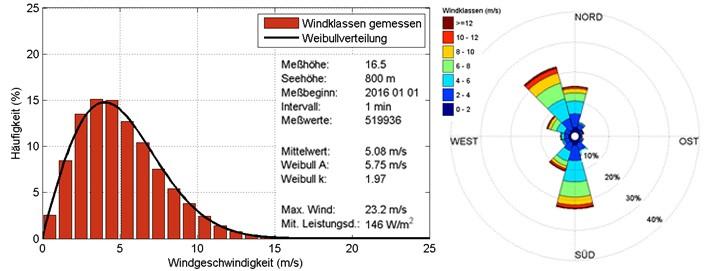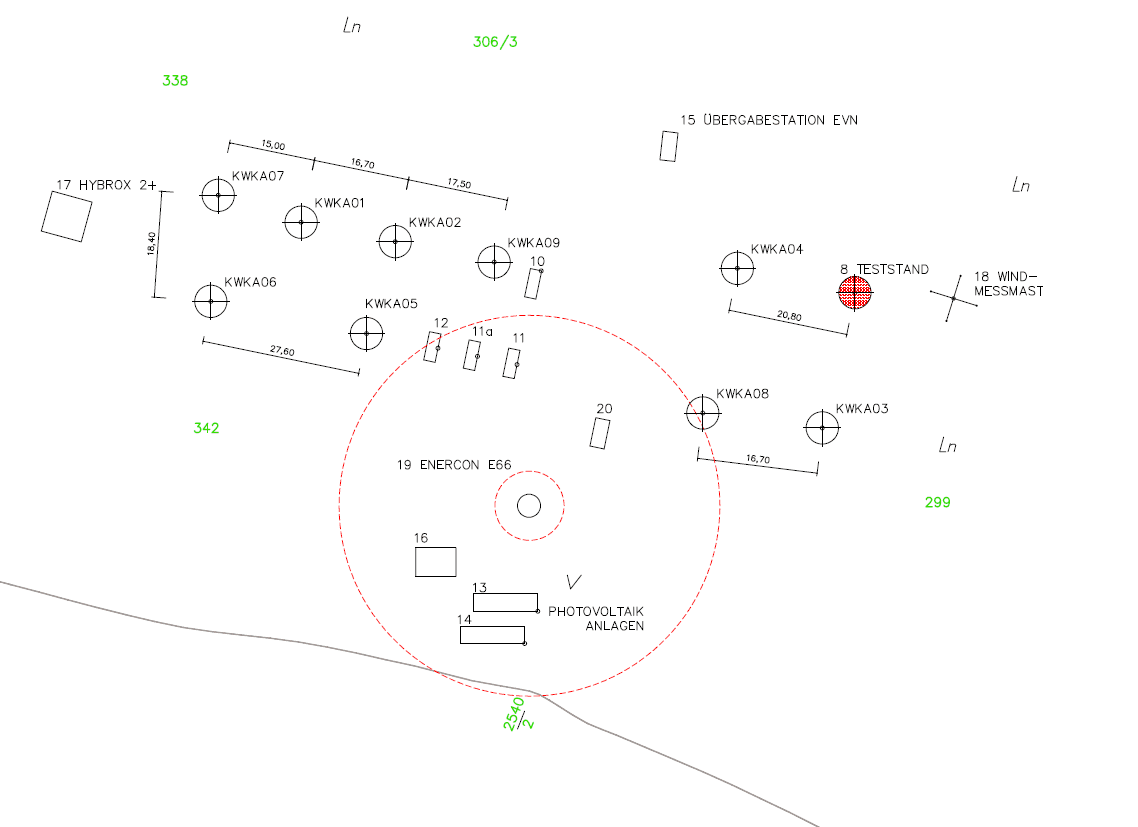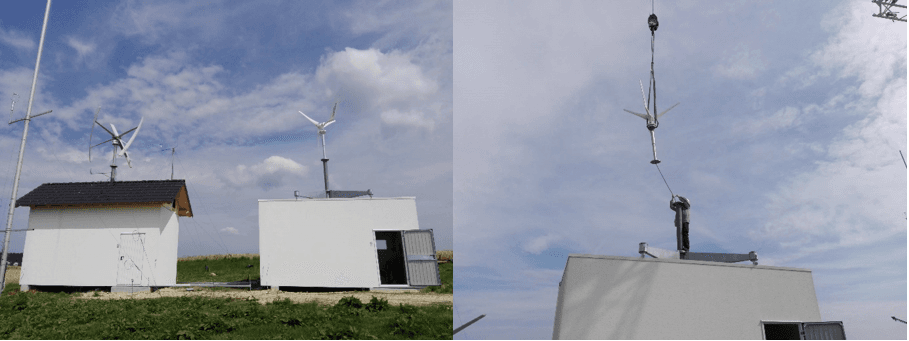Lichtenegg Energy Research Park
Energieforschungspark Lichtenegg (Lichtenegg Energy Research Park) is an independent measuring and testing facility for small wind turbines that was initiated in 2011 as part of the research project ‘Small wind turbines – quality assurance, grid connection, business models and information’ (FFG number 829731), which is supported by the Klima- und Energiefonds (Climate and Energy Fund). The energy research park has been operated by a working group comprising UAS Technikum Wien, EVN AG, Solvento and Energiewerkstatt since 2014.

Figure 25: Impressions Energieforschungspark Lichtenegg

Figure 26: Impressions Energieforschungspark Lichtenegg
Wind conditions remain constant throughout the year at this location with an average annual wind speed of more than five meters per second (at a height of 17 meters), which is above average for Austria, and with an above-average turbulence intensity, making it the ideal location for testing and measuring small wind turbines. A fact that is made apparent by the frequency distribution of wind speed and the wind rose for the Lichtenegg location depicted in Fig. 27. While the wind frequency division shows how often certain wind speeds occur within the measuring period irrespective of the wind direction, the wind rose also indicates the direction of the wind.

Abbildung 27: Häufigkeitsverteilung der Windgeschwindigkeit
Infrastructure
A measuring and testing infrastructure has been created over recent years at Energieforschungspark Lichtenegg for the neutral, manufacturer-independent testing and measurement of small wind turbines.

Figure 28: Overview Energieforschungspark Lichtenegg
Ten test benches, partly with mast systems, are available for a variety of measurements and tests (e.g. long-term evaluation, vibration and oscillation measurement, power quality, etc.) (see Fig. 28). A separate power curve mast (see Fig. 28 in red) is also located in the immediate vicinity of the wind-measurement mast, and a sound-measurement mast around 600 meters to the east of the energy research park that allows sound and power curve measurements to be carried out based on the respective standards. Besides the measuring and testing work that is carried out at Energieforschungspark Lichtenegg, free guided tours for the public are regularly organized there to provide interested parties with an insight into the subject of small wind turbines.
Measuring and testing work
The following measuring and testing work is currently available from Energieforschungspark Lichtenegg:
Long-term evaluation
Small wind turbines are operated over several months at Energieforschungspark Lichtenegg as part of their long-term assessment for the purposes of determining the quality, operational safety and functional readiness of a system. Wind and yield data are recorded at the same time to enable direct comparisons with target yields as specified by manufacturers and with other small wind turbines at the energy research park.
Power curve measurement
The electrical energy converted from wind is measured depending on the measured wind speed and displayed in tables or graphs in the form of power curves as part of the work carried out for power curve measurements. Measurements are based on the applicable standard, which is IEC 61400-12.
Power quality
Power quality measurements are used to observe different variables for the purposes of assessing the quality of the power generated by the small wind turbine being investigated (e.g. short-term voltage dips, short and long-term flickering).
Acoustic emissions measurement
The noise emissions from a small wind turbine are measured depending on the measured wind values, calculated back to the emission point and presented in the form of a noise-emission report. Measurements are based on the applicable standard, which is IEC 61400-11.
Oscillation and vibration measurement
Mass imbalances and asymmetrical rotor blade inflow along with gusts can inevitably lead to vibrations within the entire small wind turbine being operated. Oscillations and vibrations must be viewed critically particularly in regard to small wind turbines installed on buildings because they can be transmitted to the structure. The measurements provide information about the oscillation and vibration behavior of the respective systems and may be later used as the basis for developing appropriate measures aimed at reducing vibrations and oscillations.
Measurements on building-mounted systems
Two models of buildings with flat and gabled roofs were erected at Energieforschungspark Lichtenegg within the scope of the SmallWindPower@Home project. Fig. 29 shows the current interim status of this globally unique measuring and testing infrastructure (as of summer 2018). While investigations carried out so far have been limited to simulations and measurements taken from models in wind tunnels, this infrastructure presents the opportunity to measure wind turbines under real environmental conditions directly on a building and to determine the effects of building-mounted wind turbines with the aid of metrology.

Figure 29: Installation of Vertikon M and SuperWind 1250 on gable and flat roof
Further education programs
SmallWindAcademy training and further education program
The ‘SmallWindAcademy’ qualification workshop was organized in February 2019 with five companies that have been active in the field of small wind turbines in Austria or had projects in planning. The five-day training and further education program resulted in the development and implementation of a future-oriented, practice-oriented and tailor-made qualification measure for the planning and construction of small wind turbines in populated areas. Besides benefiting from the classic interactively designed transfer of knowledge, the participants were also given the opportunity to apply the knowledge they had acquired under controlled but practical conditions in cooperation with Energieforschungspark Lichtenegg and consequently achieve permanent anchoring. The qualification seminar was therefore able to make a decisive contribution to establishing small wind turbines in Austria over the long term and to do so with the appropriate quality while developing its potential.

Fig. 30: Practical day at Energieforschungspark Lichtenegg (left: installation of the small wind turbine on a building/right: electrical installation)
Guided tours for interested parties at Energieforschungspark Lichtenegg
Energieforschungspark Lichtenegg welcomes large numbers of visitors every year as a result of its growing range of offers. Up to 3,000 visitors a year are able to take advantage of the opportunity of visiting the large wind turbine and being granted access to the viewing platform and the generator room every weekend between spring and autumn. Nine more systems were installed at the energy research park in 2019 and equipped with information boards to provide visitors with an overview of current products on the market. Sanitation facilities and new information signs were additionally installed at the research park due to the growing number of visitors, especially during the summer months.